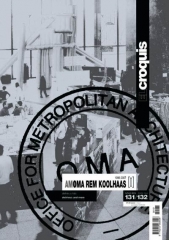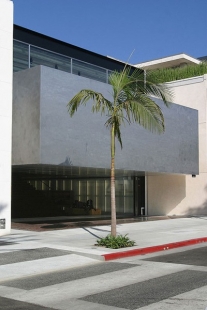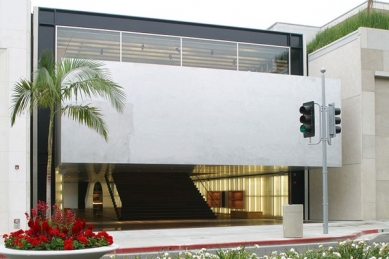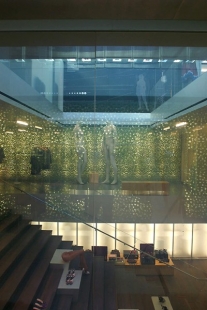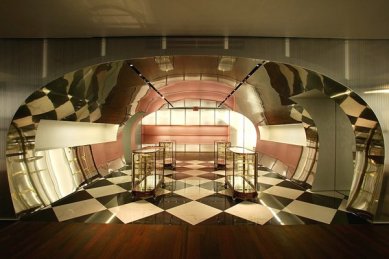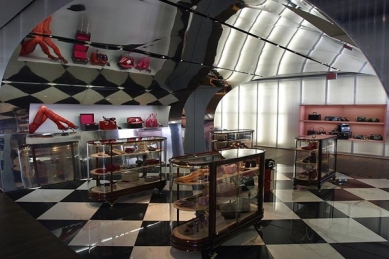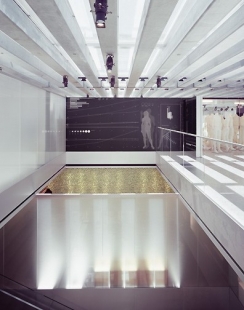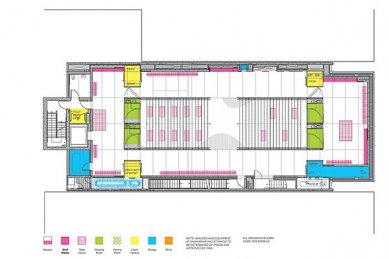
Prada Beverly Hills Epicenter

První obchod firmy Prada navržený Remem Koolhaasem leží na prestižní adrese v newyorském SoHo. Druhý obchod postavil Koolhaas na opačném konci Ameriky v Beverly Hills. Třetí a největší projekt OMA pro Miucciu Pradu musel být z finančních důvodů zrušen.
Průčelí losangelské pobočky firmy Prada představuje vlastně jen vznášející se hliníkový box. Chybí jakákoliv reklama nebo logo. Vlastně chybí i vstupní dveře nebo výloha. Interiér obchodu od ulice v horkých dnech odděluje pouze vzduchová clona a na noc se ze suterénu vysune ocelová stěna, která obchod neprodyšně uzavře. Když jdete po ulici a míjíte Pradu, tak se vám nabídne nečekaný pohled přímo dovnitř obchodu. Jakoby jste už byli uvnitř, ale přitom pořád stojíte na chodníku. Když přistoupíte blíž k obchodu, tak se ocitnete na dřevěné podlaze chráněné před počasím masivním hliníkovým boxem v prvním patře. Do dřevěné podlahy jsou zasazena tři pochůzí eliptická okna, za nimiž se vznášejí hyperrealistické figuríny Realdoll ze silikonu oblečené do drahých kostýmů značky Prada. Krásné ženy a luxusní zboží vám tady leží doslova u nohou. Poté, co minete elipsovité světlíky a překročíte vzduchovou clonou (širokou 15 metrů přes celou uliční frontu), se konečně ocitnete v obchodě.
Už Prada v SoHo se typologicky vymykala od běžných obchodních ploch. Navíc v Beverly Hill mohli pracovat se zkušenostmi nabytými v New Yorku. Bylo odtud přejato několik detailů a stavebních prvků. Zajímavou částí je válcovitý prostor ukrytý pod schodištěm, který je reminiscencí na první butik Prada otevřený v Miláně roku 1913. S inženýry z Ove Arup po boku si mohl Koolhaas vymyslet téměř cokoliv a taky toho využil. Prada neschovává jako většina jiných obchodů svoji konstrukci za sádrokarton. Nejsou odhaleny pouze obří firendelovy nosníky v prvním patře a na minimum snížena tloušťka stropu, ale také odhalená a prosklená konstrukce ploché střechy. Zajímavý je také pokrok ve vývoji nových materiálů určených výhradně pro butiky Prada, které jsou zdokumentovány zatím ve dvou knihách od Fondazione Prada. (pš)
Project summary
The new Prada Epicenter is located at 343 North Rodeo Drive in Beverly Hills and comprises a total of 24,000 square feet with 14,750 square feet of retail space on three floors. It carries the current collections for men and women: ready to wear, sport, handbags, shoes accessories and beauty.
The store’s most remarkable feature is the absence of a façade: The entire width of 50 feet along Rodeo Drive opens up to the street without a traditional storefront or glass enclosure and invites the public to enter the building. Climatic separation is achieved through an environmentally responsive air-curtain system that profits from Los Angeles’ pleasant weather. At night, an aluminum panel rises from the ground and hermetically seals the building.
Large display cones are embedded into the ground to reveal merchandise without physically obstructing the open street front. Inside the store, a large wooden stair forms a ‘hill’ – counterpart to the ‘wave’ in the New York store – that supports an aluminum box floating above the entrance. In the mirrored alcove beneath the stair-hill, the black and white marble floor and the vitrines make reference to the first Prada store from 1913 in Milan.
The aluminum box is lined with a new material specifically developed for Prada: Half matter, half air, the ‘sponge’ provides a porous artificial background for the merchandise and further expands Prada’s physical identity in its stores. The stair is framed with laminated glass fading from translucent to transparent, seemingly shrinking or enlarging the store’s size in response to the presence of customers.
A roof structure spanning the entire third floor admits daylight to the ‘scenario-space’, where the merchandise is arranged on an open, flexible floor plan. Roller tables and media gates form part of an airport-like display installation that draws reference to current security and scanning procedures omnipresent in today’s global society. The character of the space is further defined by a mural of wallpaper that – like the one in the New York store – allows for simple but radical change of the environment. A soft curtain provides a flexible enclosure and privacy for VIP and personal shopping.
Technology and Content
AMO, the research branch of OMA, has conceived the store’s technology and media content, developed together with Prada’s IT department In continuation with the approach of the New York Soho space, technology is integrated in the Beverly Hills Epicenter in an unobtrusive, functional way to enhance shopping experience and allow Prada to portray itself as a brand with a vision beyond a reductive customer profile but with a deep engagement in a larger cultural context.
‘Ubiquitous Displays’, plasma screens built into furniture or hanging between garments and merchandize, are operating as self-generating content machines: They ‘eavesdrop’, are driven by daily news feeds and stock market data and connect the store to actual events in the world outside. A mix of linguistic and image-based representations creates a ‘Wunderkammer’ of multiple visions oscillating between the world and the self. The resulting blend of ‘truth’ distorted by the (mis)interpretations of artificial intelligence is presenting a kaleidoscope of today’s mediated reality.
The dressing rooms throughout the store are equipped with ‘magic mirrors’: A plasma screen built into the large mirror allowing customers to see themselves both from the front and the back at the same time. An integrated time delay can capture and replay movements.
The elevator features a series of small LCD screens integrated into the cabin that scan virtual imagery while the elevator travels through the shaft.
After a first generation of aura and service-oriented applications, prototyped and tested in the New York Epicenter, Prada prepares for further development of a service network across all Epicenter stores. Applications of RFID systems are being further developed and will be integrated in the company. with RFID (Radio Frequency Indentification) systems being fully integrated in the company's operations.
Průčelí losangelské pobočky firmy Prada představuje vlastně jen vznášející se hliníkový box. Chybí jakákoliv reklama nebo logo. Vlastně chybí i vstupní dveře nebo výloha. Interiér obchodu od ulice v horkých dnech odděluje pouze vzduchová clona a na noc se ze suterénu vysune ocelová stěna, která obchod neprodyšně uzavře. Když jdete po ulici a míjíte Pradu, tak se vám nabídne nečekaný pohled přímo dovnitř obchodu. Jakoby jste už byli uvnitř, ale přitom pořád stojíte na chodníku. Když přistoupíte blíž k obchodu, tak se ocitnete na dřevěné podlaze chráněné před počasím masivním hliníkovým boxem v prvním patře. Do dřevěné podlahy jsou zasazena tři pochůzí eliptická okna, za nimiž se vznášejí hyperrealistické figuríny Realdoll ze silikonu oblečené do drahých kostýmů značky Prada. Krásné ženy a luxusní zboží vám tady leží doslova u nohou. Poté, co minete elipsovité světlíky a překročíte vzduchovou clonou (širokou 15 metrů přes celou uliční frontu), se konečně ocitnete v obchodě.
Už Prada v SoHo se typologicky vymykala od běžných obchodních ploch. Navíc v Beverly Hill mohli pracovat se zkušenostmi nabytými v New Yorku. Bylo odtud přejato několik detailů a stavebních prvků. Zajímavou částí je válcovitý prostor ukrytý pod schodištěm, který je reminiscencí na první butik Prada otevřený v Miláně roku 1913. S inženýry z Ove Arup po boku si mohl Koolhaas vymyslet téměř cokoliv a taky toho využil. Prada neschovává jako většina jiných obchodů svoji konstrukci za sádrokarton. Nejsou odhaleny pouze obří firendelovy nosníky v prvním patře a na minimum snížena tloušťka stropu, ale také odhalená a prosklená konstrukce ploché střechy. Zajímavý je také pokrok ve vývoji nových materiálů určených výhradně pro butiky Prada, které jsou zdokumentovány zatím ve dvou knihách od Fondazione Prada. (pš)
Project summary
The new Prada Epicenter is located at 343 North Rodeo Drive in Beverly Hills and comprises a total of 24,000 square feet with 14,750 square feet of retail space on three floors. It carries the current collections for men and women: ready to wear, sport, handbags, shoes accessories and beauty.
The store’s most remarkable feature is the absence of a façade: The entire width of 50 feet along Rodeo Drive opens up to the street without a traditional storefront or glass enclosure and invites the public to enter the building. Climatic separation is achieved through an environmentally responsive air-curtain system that profits from Los Angeles’ pleasant weather. At night, an aluminum panel rises from the ground and hermetically seals the building.
Large display cones are embedded into the ground to reveal merchandise without physically obstructing the open street front. Inside the store, a large wooden stair forms a ‘hill’ – counterpart to the ‘wave’ in the New York store – that supports an aluminum box floating above the entrance. In the mirrored alcove beneath the stair-hill, the black and white marble floor and the vitrines make reference to the first Prada store from 1913 in Milan.
The aluminum box is lined with a new material specifically developed for Prada: Half matter, half air, the ‘sponge’ provides a porous artificial background for the merchandise and further expands Prada’s physical identity in its stores. The stair is framed with laminated glass fading from translucent to transparent, seemingly shrinking or enlarging the store’s size in response to the presence of customers.
A roof structure spanning the entire third floor admits daylight to the ‘scenario-space’, where the merchandise is arranged on an open, flexible floor plan. Roller tables and media gates form part of an airport-like display installation that draws reference to current security and scanning procedures omnipresent in today’s global society. The character of the space is further defined by a mural of wallpaper that – like the one in the New York store – allows for simple but radical change of the environment. A soft curtain provides a flexible enclosure and privacy for VIP and personal shopping.
Technology and Content
AMO, the research branch of OMA, has conceived the store’s technology and media content, developed together with Prada’s IT department In continuation with the approach of the New York Soho space, technology is integrated in the Beverly Hills Epicenter in an unobtrusive, functional way to enhance shopping experience and allow Prada to portray itself as a brand with a vision beyond a reductive customer profile but with a deep engagement in a larger cultural context.
‘Ubiquitous Displays’, plasma screens built into furniture or hanging between garments and merchandize, are operating as self-generating content machines: They ‘eavesdrop’, are driven by daily news feeds and stock market data and connect the store to actual events in the world outside. A mix of linguistic and image-based representations creates a ‘Wunderkammer’ of multiple visions oscillating between the world and the self. The resulting blend of ‘truth’ distorted by the (mis)interpretations of artificial intelligence is presenting a kaleidoscope of today’s mediated reality.
The dressing rooms throughout the store are equipped with ‘magic mirrors’: A plasma screen built into the large mirror allowing customers to see themselves both from the front and the back at the same time. An integrated time delay can capture and replay movements.
The elevator features a series of small LCD screens integrated into the cabin that scan virtual imagery while the elevator travels through the shaft.
After a first generation of aura and service-oriented applications, prototyped and tested in the New York Epicenter, Prada prepares for further development of a service network across all Epicenter stores. Applications of RFID systems are being further developed and will be integrated in the company. with RFID (Radio Frequency Indentification) systems being fully integrated in the company's operations.
0 komentářů
přidat komentář


